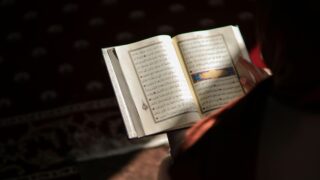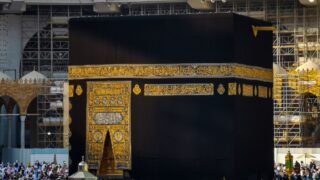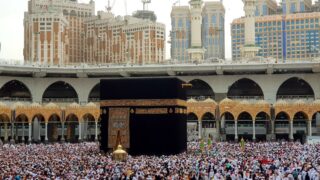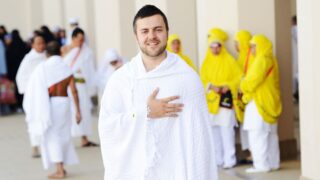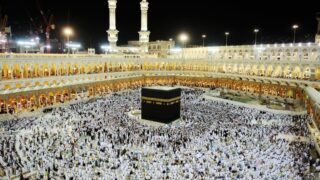Prior to 1982, my knowledge of Hajj had been limited to what I could gain from books, and so, when at last in that year I had the privilege of performing this religious duty, I felt myself singularly blessed. Although the rites of Hajj are spread over only a few days, as symbolic guidelines, they stand people in good stead for the rest of their lives. The message of Hajj, as I now comprehend it from the study and performance of it, is that people should make the Almighty the very pivot of their existence, hastening at His call to do His every bidding.
When people leave their home and country to go on such a pilgrimage, they brim over with all the emotions aroused by the thought that they are embarking on a course that will lead them directly to God. They are, in effect, sloughing off their own world, leaving it behind them, and reaching out for the world of the Almighty. They are on their way to the House of God, a place where the great deeds of God’s messengers and their followers have been preserved for all eternity; where we find the hallowed impressions of the lives of those who lived and died for the cause of God. The pilgrims are then filled with the realization that they are bound for the very destination that God especially chose for His last revelation. Once launched on this course, the pilgrims are imbued with the awareness of God and His truths, as well as the feeling that it is imperative that they become God-oriented. If, up till then, they had been self-centered in their thinking, they now turn their thoughts to God, and their entire behavior is molded and transformed by these new thought processes.
Once the pilgrims’ trains of thought have become God-oriented, they begin to ponder over major issues: God’s act of creation, particularly His creation of the pilgrims’ own selves; God’s affording the pilgrims diverse opportunities of bettering themselves in this world; God’s very benevolence, which makes it possible for the pilgrims to set forth on this journey to the House of God. The pilgrims also give their minds to the day when they will meet their death and be summoned to the court of God. This trend of thought turns the ostensible physical journey of the pilgrims into an intense, spiritual venture.
When the time nears for their entrance into Al-Haram (sacred territory), all the male pilgrims divest themselves of their clothing in order to don a new kind of “uniform” — an unstitched, plain, white garment that serves to heighten their consciousness of entering a new world. The very act of shedding their normal clothes (and with them all signs of status and ethnicity) signifies that they are separating themselves from the way of life peculiar to their environment and are now ready to become suffused with such emotions as are desired by God. In this way, thousands of men cast off their own hues and take on the hue of the Almighty. After clothing themselves in ihram, the pilgrims find their tongue beginning to utter godly words — “Labbayk, Allahuma, labbayk!” — and they continue, as if hastening to answer God’s call, to repeat the word “labbayk” — “O God, I am here, I have come!
Labbayk (I am here) does not mean just that the pilgrims have come to stay in Makkah. It means that in leaving their normal abode they have cast aside their whole way of life. It means, “I am here, at Your command, and with all my heart and soul I am ready to obey You.” While on their pilgrimage, pilgrims simply give utterance to the word “labbayk,” but when they return to their own countries, they must put it into practice in their everyday lives.
On reaching Makkah, the pilgrims must perform Tawaf (circumambulation). To do this, they enter the House of God — the great mosque in whose spacious central courtyard stands the Ka`bah — that was erected by the Prophet Abraham in ancient times. Then the pilgrims go round the Ka`bah seven times to demonstrate their willingness to make God the pivot of their whole existence.
After the Tawaf, there comes the ritual of Sa`i, which entails brisk walking from the hill of Safa to the hill of Marwah and back again. This procedure is repeated seven times in symbolic enactment of a promise, or covenant, to expend all of one’s energies in the path of God. The form that this ritual takes can be traced back to the Prophet Isma`il’s mother Hajar, when she was running from one hill to another in a frantic search for water for her young baby.
The most important period of worship during Hajj is the day-long sojourn on the plain of Arafat. It is indeed an awesome spectacle, with people from all over the world clad in identical simple white garments chanting “Lord, I am present, Lord, I am present.” This serves to impress upon the mind of the pilgrims how great a gathering there will be in the presence of God on the last day, the Day of Reckoning. Once the pilgrims become aware of its true significance, all their problems fall into their true perspective, and their life cannot but take a turn for the better.
Another practice during Hajj is the casting of stones at Jamrat Al-`Aqabah. This is a symbolic act through which the pilgrims renew their determination to drive Satan away from them. In this way, they make it plain that their relationship with Satan is one of enmity and combat. The next step for the pilgrims is to turn their piece of symbolism into reality so that they may be purged of all evils, for all the evils besetting humankind are there at the instigation of Satan.
After this, the pilgrims sacrifice an animal to God, an act symbolizing the sacrifice of the self. Their faith is such that even if it comes to giving their life — the last thing that they would normally be ready to part with — they will not hesitate to do so in the service of God.
By Wahiduddin Khan *


